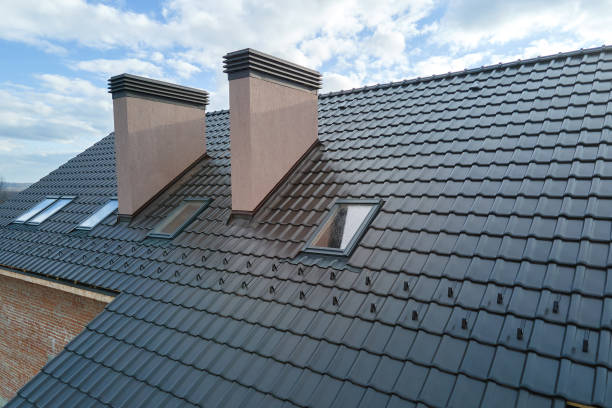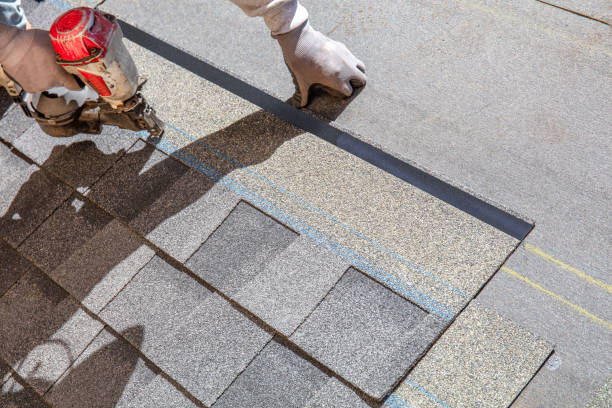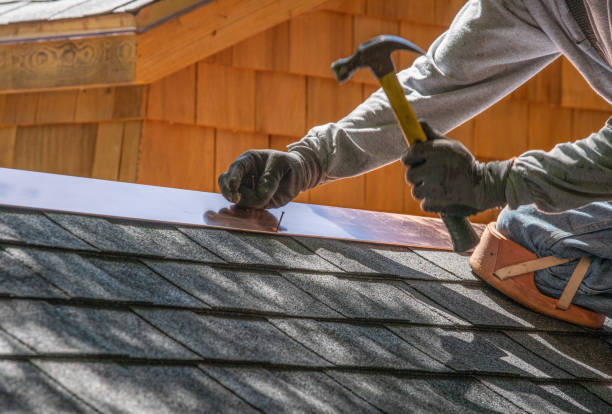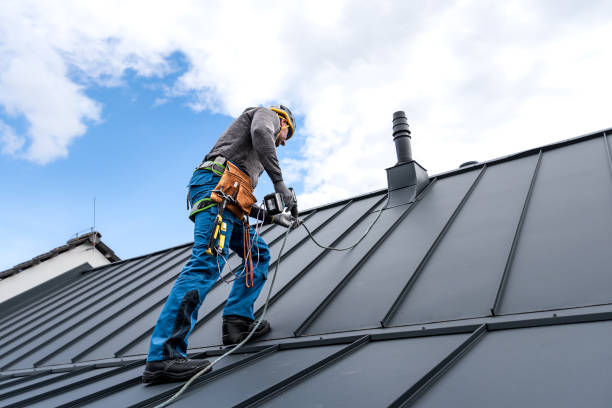
Comprehensive Guide to Roofing Installation of Your Home
Roofing is one of the most important parts of your house. With a roof installed, you are perfectly protected from the elements by keeping you, your family, and your belongings safe and dry. This makes your home insulated, weather-resistant, and safe for years to come. Roofing installation is not a lighthearted affair since it cuts across detailed planning, material selection, and expert advice. Whether it is for a newly built house or replacing the old and worn-out roof, understanding the process in detail is quite crucial.

Why is proper roofing installation important?
But before getting into the nitty-gritty of roof installations, it becomes important to understand why they matter. A badly installed roof can have some major problems – it leaks, wastes energy, grows mold, and even has structural effects on your house. On the other hand, it’s a long-lasting form of durability where your roof will go further in life but demands fewer repairs in the future.
Energy Efficiency
Sufficient insulation and roofing material ensure the temperature inside your house does not swing too much. In other words, this helps you save on your energy bills.
Safety and Security
A good roof protects your house from rain, snow, wind, and other extreme conditions.
Boost Property Value
An elegantly installed beautiful roof can boost the curb appeal and value of your property.
Selecting Your Roofing Material for Your House
The selection of roofing material will go a long way in deciding its robustness, appearance, and maintenance requirements. Each material has pros and cons associated with it, and therefore, this decision needs to be wisely taken. Amongst the types of roofing materials used most widely, the following are commonly used in residential roofing:
1. Asphalt Shingles
The most cost-effective form of roofing available in North America is the asphalt shingle, which not only is inexpensive but also easy to install and comes in numerous styles. These most basic mats are made from asphalt but coated with ceramic granules to protect against UV.
Typically, the lifespan of asphalt shingles is between 20 and 30 years, contingent upon the quality of materials used and the location’s climate.
Cost
Asphalt shingles are very cheap, and one of the cheapest roofing materials available.
Aesthetic Appeal: They come in a wide range of colors and styles to ensure that it is quite easy to find a perfect match for your home’s architectural design.
2. Metal Roofing
The best thing about metal roofing is that it looks modern, long-lasting, and friendly to the environment. They are made from steel, aluminum, or copper and can come as big panels or shingles.
Durable
Metal roofs last between 40 to 70 years. This usually depends on the kind of metal used and how well they are being maintained.
Energy Efficiency
Clay and concrete tiles reflect sunlight and less heat is transferred into your house. That means energy spent during summer months is reduced.
Cost
Expensive than any other alternative and needs a bigger upfront investment than asphalt shingles, however, the extended lifespan and energy savings make this higher cost merely a down payment on your roof’s extended life cycle.
4. Slate Tiles
While clay and concrete tiles do indeed have their appeal to the more traditional or Mediterranean-look homebuyer, they can be pretty heavy on the roof structure.
Long-term durability
Clay and concrete tiles will generally last over 50 years, assuming they have been properly cared for. Clay tiles even throw in the added layer of fire and elemental resistance.
Cost: Clay or concrete tiles may be expensive at the onset, but their long-term life will most likely pay off.
Aesthetic Appeal
Clay and concrete tiles have a rustic look and seem ageless which will add drastically to the curb appeal of your home.
4. Slate Roofing
Slate must certainly be one of the toughest and most beautiful roofing materials there is. It is, after all, naturally stone-made and features an extremely chic, unique look that simply cannot be rivaled by other, similar materials.
Durability
A slate roof installed perfectly can last more than 100 years without even showing the first signs of serious damage. Thus, this is one of the longest service lives found in a roofing material.
Cost
Slate is one of the costliest roofing materials primarily because the material itself and labor for installation are pretty costly.
Aesthetic Appeal
Slate gives an appearance that is tasteful and lavish and can add a lot of bucks to the value of your house.
5. Wood Shingles and Shakes
Wood shingles and shakes would give a very natural, wooden, and old look that works for almost any architectural style. However, they have proven to be more maintenance demanding compared to other material-based options and even compromise on some amount of fire and weather resistance.
Durability
The roof material of wood shingles and shakes would last for a period of around 20 to 40 years, based on the type of wood material used as well as the maintenance.
Cost
Roofing material made from wood moderately costs but requires maintenance to be called upon for repair so that rot, as well as pest problems, do not begin.
Appearance
Roofing wood provides homes with a distinct, natural look that can be attractive if the right style is chosen to enhance the house’s charm and character.
The following are factors to consider in selecting the best roofing material; in this way, you’ll be sure that your choice meets your expectations. Some of the most basic considerations include;
1. Climate and Weather Conditions
The climate in your area plays a major role in determining the best roofing material for your home. For example, asphalt shingles will never be an option that will not make it optimum for areas with extreme heat while metal roofing takes well to both hot and cold climates. In hurricane-prone areas, the option might be impact-resistant such as metal or tile.

2. Budget
Your budget would most likely be one of the major factors that would influence your decision. Certain ones, like slate and metal, could even turn out to be costlier at first, but those could very well prove cost-effective in the long term because they tend to endure for much longer compared with others. The cheaper ones, like asphalt shingles, would require more frequent replacement or repair.
3. Maintenance Needs
Another thing that has to be taken into consideration in picking a roofing material is maintenance. Each material needs something different concerning its maintenance. There are needs that wood shingles have in terms of periodic checking and treatment to prevent rot. On the other hand, metal roofing does not need much or at all. Consider your time and energy in maintaining your roof.
4. Aesthetics
Its appearance contributes a lot to the general view of your house. Relating to curb appeal, the look of your roof is of excellent value. Clay tile and slate give you that timeless and elegant look, but the metal finishes give you that sleek modern look. Whatever you are going to choose, make sure you pick what fits the architectural design of your home.
5. Durability
That would depend on how long you will stay in your house. If you will be staying there for several decades, then it will be practical to install costly but very strong materials like slate or metal. If it will just be a short time in your house, then you might just use asphalt shingles.
The Roof Installation Process: Step by Step
Once you’ve chosen your roofing material, it’s time to get out there and make the installation. Understanding each step of the roofing installation process may help you to be sure that the job will be done correctly and give you peace of mind that your new roof will last for years to come.
1. Roof Inspection and Preparation
Any good roofer will inspect your current roof before starting. She or he will check the whole roofing structure to identify any weakening damage from rot, leaking water, or mold growing. If it has been badly damaged, then those should be corrected or reinforced before starting the installation of the new roof.
Decks
Sometimes, the plywood or decks beneath the old roofs have become rotten or have deteriorated, and will have to be replaced.
Measuring and Planning
The professional will take accurate measurements so that he will know how much material is needed and what plan should be used in his installation.
2. Removal of the Old Roof
For a roof that is already in place, the old materials have to be torn off before the new one can be installed. In most terms, it is known as a “tear-off,” but it includes removing the old shingles, underlayment, and flashing.
Debris disposal
Several companies quote the disposal of debris in the project quotation. Therefore, you can be assured that the wrecked materials are disposed of properly, and your properties are always kept clean and safe while the installation is being undertaken.
Installation of underlayment
The underlayment is the first protection line between your roof decking and shingles. It’s a moisture barrier where water would not pass through inside when the shingles or tiles are broken.
Types of Underlayment
Most of the underlays common are synthetic, felt, and self-adhering underlays. It is up to your contractor to recommend the best for you depending on the type of roof and the climate in which the building lies.
4. Flashing Installation
Flashing is applied around any roof penetration, such as chimneys, vents, skylights, and valleys. It allows water to run out at these weak areas, thus avoiding drips and water damage.
Importance of Proper Flashing
Installing flashing is a must step to be taken in the process of the roof installation. Poor flashing is one of the main causes of leaks in the roof. Do not forget to make sure that your roofing installation contractors are proficient and effective in flashing installation.
5. Installing Roofing Material
Now the underlayment and the flashing are all complete, the roofing material can now come down. The installation itself will be entirely dependent on the kind of material.
Asphalt Shingles
Overlaps for most shingles, down from the bottom up.
Metal Panels
Screws the metal roofing panels on the roof deck, however, sometimes they install with a seam that interlocks for added protection.
Tile or Slate
Tiles or slate are applied individually, usually from the roof edges and inward.
Choosing the Right Roofing Company
Regardless of how much study is conducted and how keenly your selections are made, the success of a roofing installation is likely to depend more on who you hire as a contractor. You are therefore guaranteed that an older and experienced Roofing Installation Contractor delivers the job perfectly, safely, and within time. Here’s how to get the right contractor for your project:
1. Ask for referrals
Start by asking your friends, family, and neighbors if they know reliable good roofing contractors in your area. Personal recommendations are the best way to source trusted professionals who have done quality work for years.
2. Online Reviews
Other good online resources include Google, Yelp, and the Better Business Bureau. In any case, always make sure to do your homework before hiring a roofing contractor by seeing if they have some good ratings and reviews from customers. And of course, be suspicious about an open complaint or questionable track record of work done.
3. Check out Credentials and Insurance
Ensure that the roofing contractor you hire is licensed and insured. That way, if there is an accident or damage when a project is undertaken, you will be covered. A good installation roofing contractor will not have problems showing you evidence of insurance and licensure should you request them.
4. Obtain multiple quotations
It also makes sense to have a minimum number of three quotes from different contractors before making the final choice. This will help you in comparing prices, services, and warranties. Sometimes, the least expensive is not the best; but rather value is paramount, not cost alone.
5. Closely Read Contracts
After you have identified your contractor, always ensure that you go through the contract so you can sign on what it has on it. Ensure all details, including work scope, materials, payment terms, and completion date, are well-mentioned. A clear and explicit contract always saves people the agony of miscommunication, which is one of the major reasons people disagree in the end.
Post-Installation Care and Maintenance
After you get a newly installed roof, the next thing is proper care and maintenance to get the best out of your new roof. Here are the main basic maintenance of your roof to keep it in good condition:

1. Roof Inspections
You will want to institute a regime of annual inspections with Roofing Repair Experts. Things to look for damaged shingles, loose flashing, and any evidence of water damage or leaks.
2. Clean Your Gutters
Clogged gutters can cause water to back up onto your roof, producing leaks and harm caused by high amounts of water. Clean your gutters regularly, preferably fall, when leaves and debris quickly enter your gutters.
3. Trim Overhanging Trees
Hanging branches above your roof can cause rubbing on the shingles during a gusty day or drop the leaves with debris on your roof, causing further damage. Trimming them on the sides can prevent roof damage and leakage.
4. Take Necessary Repairs Right Away
Act now if you have some sort of damage like lost shingles or water stains on your ceiling. Not acting to conduct needed repairs may become an even worse situation and, thus, an even costlier affair in the future. Reach out to Roofing Repair professionals to fix anything fully.
5. Search for Moss and Algae Growth
Areas with moisture, moss, and algae will thrive. Shingles deteriorate faster. So observe for both of these and clean with a soft brush or a cleaner safe for your roof.
Conclusion
Roofing installation is an investment; thus it must be done right in the first instance. This is done when properly fulfilled by using good materials, hiring experts in Professional Roofing Installation, and proper maintenance practices that will ensure a long life of your roof and provide reliable protection to you.
Be it a new roof from the ground up or replacing an older roof, this all-inclusive guide will help the right decisions along the way. Your home is worth your time in planning, preparing, and coupling the appropriate roofing installation contractors to make it right. A solid, beautiful roof that lasts a long time is one of the biggest investments you can make in the future of your home.
